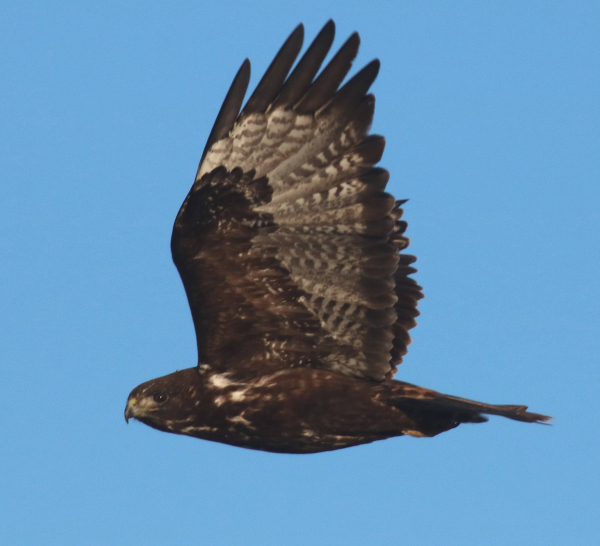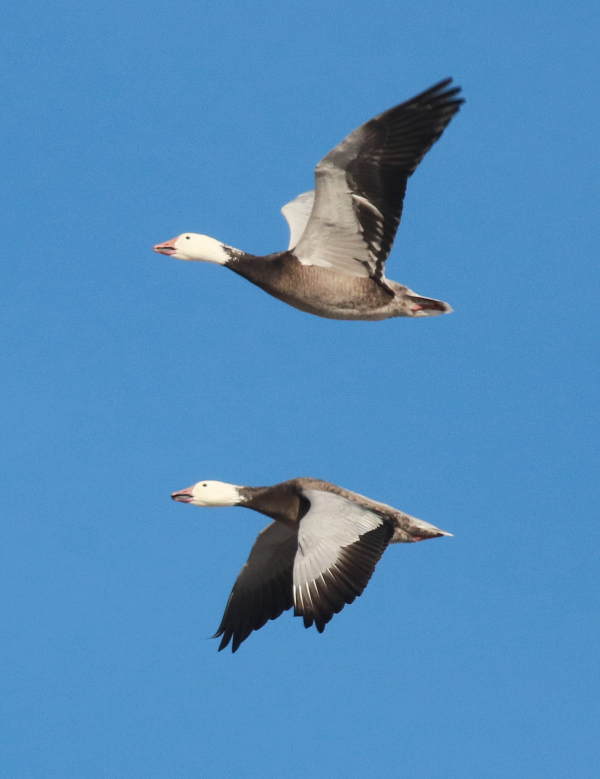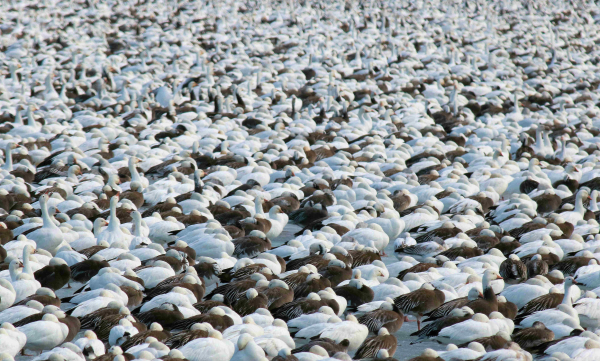
A big dark morph Harlan’s Hawk provided an exciting highlight last week.

Rather than photographing throngs of geese, Paul concentrated on small flocks and pairs of Snow Geese, including this threesome that were involved in a lengthy chase with lots of twists and turns – possibly for fun, possibly as a precursor to pairing.

Blue geese, that is, blue morph Snow Geese, offer a colorful variation to the white Snows that outnumber the blues by almost two to one.

Although it may be hard to see in a small version of this photo, most geese at Sand Lake Refuge laid their head on their back for a quick “goose nap” before the evening feeding flight.
|
Tuesday, thousands and thousands of geese invaded, surrounded, and flew low above my Dakota house spreading goose music across the land the whole day and into the night. It’s a time I await and hope lasts as long as possible each spring as these dynamic birds migrate across the continent, from Gulf Coast marshes to Arctic tundra ponds. But it’s here in the center of the Central Flyway the geese stop to rest, recharge, feed, gear up for nesting, and wait for the Arctic to thaw.
The following afternoon as I drove north from home, for 12 miles I marveled at what seemed like never-ending flights of Snow and Ross’s Geese that stretched across the sky, unbroken for those dozen miles – some flying north, most flying west – high, low, and in between!
During the same drive, I counted 3 Bald Eagles, 3 American Kestrels, and 28 Red-tailed Hawks, including two striking dark morph Harlan’s Red-tails. The top raptor sighting was one of the Harlan’s, a big black female that flew toward my vehicle about eye level in height, then flaring its broad wings as it landed on a post just 10 feet away as I drove by. What a spectacular bird – so rare in these parts, and most other parts of the country. It was very overcast, counting out any photo attempt, but it sure was fun to witness such a stunning raptor so close – if only for a fleeting moment.
Thursday, local goose flocks were dominated by Cackling Geese, the miniature version of Canada Geese that nest on the Arctic tundra. Invariably, flocks of Cacklers contain a few much larger Canada Geese on the edges, a couple White-fronted Geese, and one flock even had a pair of Ross’s Geese. There were a few small flocks of Snow Geese in the area, but much fewer than the previous two days. The geese on the ground were bound by their attraction to the limited trickles of open water on the edges of marshes. During the next couple days, a virtual heat wave with temperatures in the 50s would open much more water.
Red-tailed Hawks were even more abundant through the area Thursday, stopping to hunt and rest it would seem. A couple hundred yards from home the motion of a bird landing on the very top of a tall spruce tree gave me a hunch, so I stopped to take a closer look through binoculars, which verified the bird was a Merlin. It looked like a female from the front, but when I repositioned and checked it from the side, the little falcon turned out to be a nice gray-backed male.
Friday morning some major flights of Snow Geese were passing overhead, headed west and northwest. When I checked on one flock of Cackling Geese that had some Canadas mixed in, I was surprised to find three big Tundra Swans in their midst – the first swans of spring.
As expected, the sun broke through mid-afternoon, which made me evacuate my office and escape for Sand Lake Refuge again – if it’s Friday, I must be at Sand Lake – at least that’s the way it’s worked the past three Fridays in a row. Along with the first Killdeers of the season, most of my sightings along the way were within the current norm – several Red-tailed Hawks, a few Northern Harriers, a few Bald Eagles, and an American Kestrel, along with widely scattered flocks of geese.
Sand Lake III
With all the geese passing through my neighborhood, I wasn’t sure if the concentration of geese at Sand Lake National Wildlife Refuge had pressed farther north. With the weekly changes I’ve seen each Friday, anything could have happened during the past week. As with the two previous weeks, there were no indications of what was to come until I was within a mile of the refuge, when a cloud of Snow Geese rose up from one edge of the mostly frozen wetland, plus a second cloud was evident to the north. When I had a full view of the scene, it was clear there were many, many, many more geese – again.
If there were a couple hundred thousand geese the Friday before, there must be more than a half-million this afternoon! The sight before me was astounding! It’s not like I haven’t seen an expansive concentration of Snow Geese before, but usually they flock into the middle of the broad wetland, far beyond camera range. Friday, the geese were standing on the ice just 30 yards from the road en masse, which made the scene all the more exciting – and then the flock took flight, rising up with a roar but returning to the ice after a short flight, with the edge of the mass landing even closer than before – WoW!
I appreciated the opportunity to photograph the geese at close quarters again, on the ice and in the air. I concentrated on photographing small flocks and pairs as they flew by, only to vanish as they landed among the throngs of geese that blanketed the still frozen wetland. Although the white morph Snows are always most abundant, the blue morph Snow Geese pepper the flocks with color, and the mini-Snows – the Ross’s Geese – added a vague variety to the expansive mix.
Thereafter, the geese were pretty relaxed and most were openly dozing with their head resting on their back. There seemed to be a much smaller percentage of Ross’s Geese among the Snows now, although that’s always hard to assess in the field. Across the road, new ducks were evident in the shallows, including Lesser Scaup, Redheads, a few Buffleheads, a pair of American Wigeons, and a regal pair of Canvasbacks. The huge concentration of Snow Geese rose up to the north, and most settled back, but flocks totaling a couple thousand flew south to join the closer geese. Soon thereafter, I began my return trip home after a cloud bank expanded over the area from the south.
What a week! Enjoy the birds around you day by day as April begins – stay safe, be healthy, Best Wishes!
Article and photos by Paul Konrad
Share your bird sightings and photos at editorstbw2@gmail.com